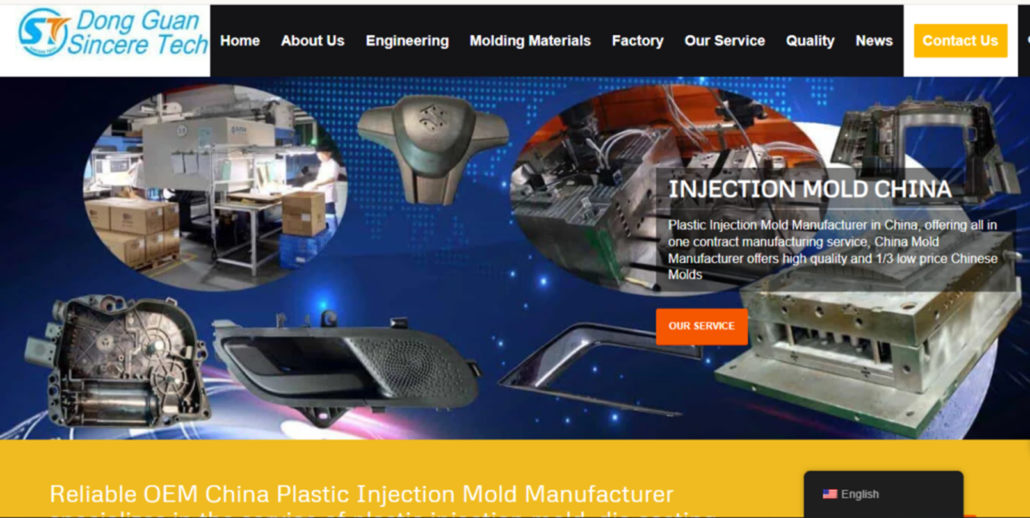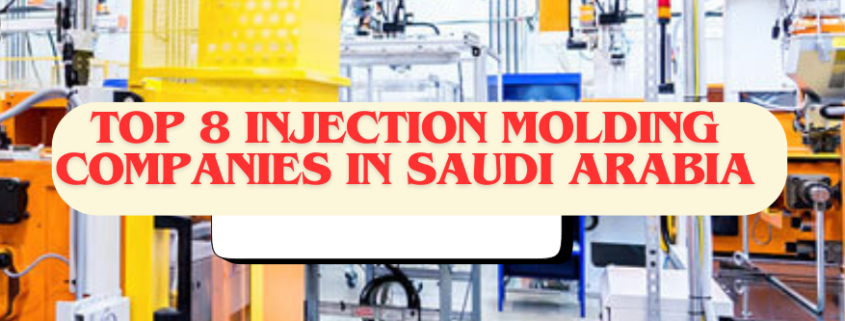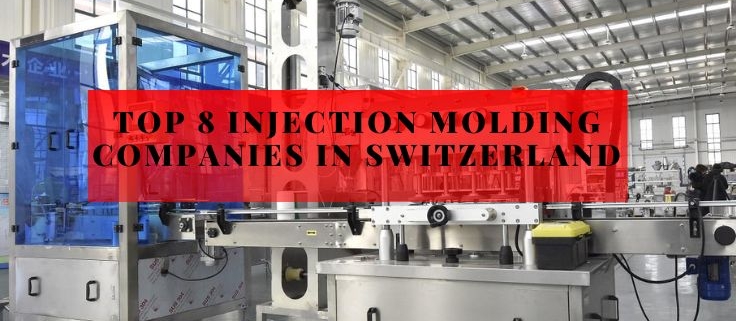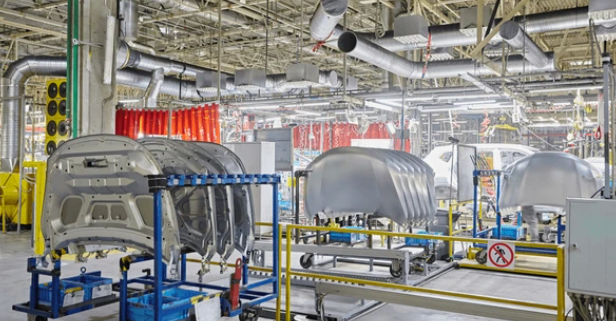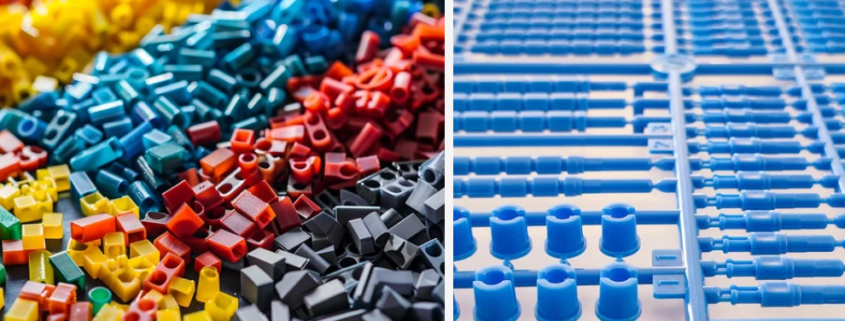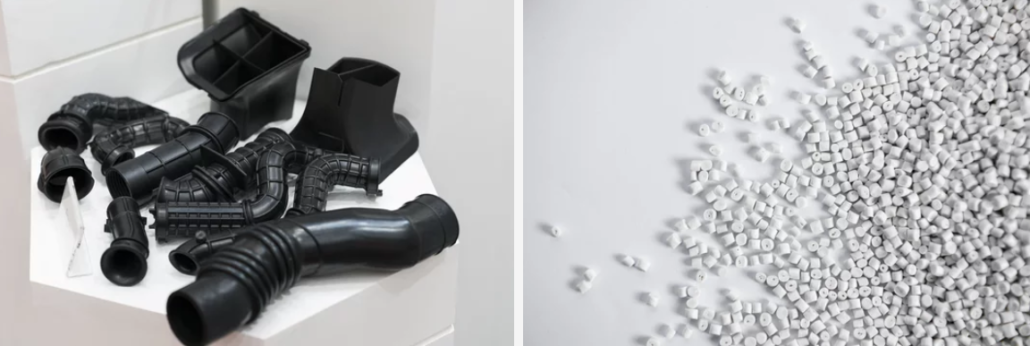Being home to some of the world’s leading injection molding companies, Malaysia has evolved from a country based on agriculture since gaining independence in 1957 to a striking industrial hub. Because of its strategic location, pool of skilled workforce, and business-friendly environment has attracted global investments, making it a key player in electronics, automotive, medical devices, aerospace, and plastic manufacturing. The Malaysian government’s initiatives, such as the New Economic Policy (NEP) and Vision 2020, have further spurred technological and sustainable growth. Over the last few decades, Malaysia has steadily become a leading force in the plastic injection molding industry, catering to local and international markets. Broadly, Malaysian companies encompass a broad spectrum of industries, such as automotive, medical devices, consumer electronics, and aerospace, along with home appliances and construction, which produce and supply high-quality components to the rest of the world. Malaysia is a leader in high-tech injection molding because of the adoption of advanced automation, robotics, and precision engineering, and its machinery is 60 – 2000 Tons.
Advance Plus Moulds & Injections Sdn Bhd, YPC (Malaysia) Sdn Bhd, and MDP Plastics Sdn Bhd, for example, have moved into global markets. Malaysian factories are strongly committed to quality standards, as depicted by ISO 9001, ISO 14001, and RoHS. This reflects Malaysia’s status as one of the highest contributors to ASEAN’s FX manufacturing exports, where such commitments are driven by continuous innovation and R&D investments.
In this article, we list the top 10 injection molding companies in Malaysia that produce the highest-quality injection-molded products.
1. Advance Plus Moulds & Injections Sdn Bhd
Year of establishment: 1987
Number of employees: 100-250
Business type: The company mainly manufactures double-color molds and 2K molds with high-precision molding and plastic injection molding
Website and Contact
Website: https://plasticmouldinjection.com.my/
Email: clleong@apmisb.com.my
Phone: +603 8723 280
Address: 27 Jalan P 4/6, Semenyih, Selangor, Malaysia
Company Profile
Advance Plus Moulds & Injections Sdn Bhd, originating in 1987 as Advance Engineering Work, has developed into a Malaysian mainstay providing high-precision mold fabrication and plastic injection molding. In 1993, its production increased to Desa Tun Razak, Cheras. The company was rebranded in 2000 and expanded in 2004 by opening a 27,600-square-foot facility in Bandar Teknologi Kajang. It had a branch in Thailand in 2015, and its start was in the international presence. The company is ISO 9001:2008 certified with the continued obligation to quality, innovation, and global excellence.
Services
- Plastic Injection Molding
- Mold Fabrication and Tooling
- Secondary Processes
- Research and Development
- Maintenance and Repair
Pros
1. It possesses over three decades of experience in mold fabrication and plastic injection molding
2. ISO 9001:2008 certification is Quality Assurance.
3. Expansion globally – Presence across Thailand and Malaysia enhances reach and trust to more clients.
Cons
1. Limited Online Transparency – Lack of detailed financial or employee information on the website.
2. Primarily, geographical limitation – it has its base in Malaysia and has limited production facilities worldwide.
3. Advanced Moulding Techniques – Advanced molding techniques will increase client costs.
2. Edverson Marketing Sdn Bhd
Year of establishment: 1989
Number of employees: 200-300
Business type: It is a manufacturing company specializing in custom precision plastic injection molding and tooling manufacturer for automotive, electronics, home appliances, and consumer goods based on innovation.
Website and Contact
Website: http://www.edverson.com.my/
Email: info@edverson.com.my
Phone: 604-582 6385
Address: Pulau Pinang, Malaysia.
Company Profile
The manufacturer is Edverson Industries Sdn. Bhd. is a Malaysian company focusing on precision plastic injection molding and tooling. It began with the base establishment. It was built from this foundation by investing in the most modern machinery, hiring highly skilled personnel, enlarging the premises, and establishing strong relationships in the automotive, electronics, and consumer sectors. Edverson is produced with high quality and operational excellence; it has ISO 9001 certification. As the company’s innovation, proprietary techniques, lean methodologies, and automation consistently brand the company with superior product quality and global customer satisfaction, it never deviates from its commitment to excellence.
Services
- Plastic Injection Molding
- Mold Fabrication and Tooling
- Research and Development
- Quality Assurance and Control
Pros
1. Quality Moulding—Over the years, Edverson has developed its reputation for quality molding in an industry with decades of experience.
2. ISO 9001 certification – Reassures the consumer that the company manufactures uncompromisingly top-quality products.
3. Company Investment in Advanced Technology and Lean Manufacturing – This is used to be efficient.
Cons
1. Not much public data about the company’s operations is available, but on information, some more can be provided.
2. The higher prices – precision manufacturing and state-of-the-art machinery.
3. Monetary Policy – This focuses on Malaysia and occasionally has a small global expansion.
3. Glasfil Polymer Sdn. Bhd
Year of establishment: 1992
Number of employees:100-250
Business type: This Malaysian manufacturing facility provides plastic injection molding services and mold fabrication services to various business sectors.
Website and Contact
Website: https://glasfil.com/
Email: info@glasfil.com
Phone: +603-8961 8509
Address: 19, Jalan Taming, P/1 Off Lebuh Taming, Taman Taming Jaya,43300, Balakong, Selangor Darul Ehsan , Malaysia.
Company Profile
Since its establishment in 1992, Mr. Chee has launched the plastic injection molding and fabrication company Glasfil Polymer Sdn. Bhd. Since 1992, the company has expanded from 13 machines to 19 under Ms. Samantha’s leadership, who became her father’s successor, Mr. Chee. Glasfil has performed over 7,000 projects serving clients in the automotive, electronic, and construction sectors. It has been in the market for nearly 28 years, servicing over 28 countries, such as Japan, Dubai, the US, and the UK. Quality innovation and sustainability represent key elements of the organization since it holds ISO 9001:2015 certification. Modern technology supports Glasfil to deliver efficient production at high industry standards through its full range of internal services.
Services
- Research & Development
- Plastic Injection Moulding Technologies
- Secondary Process
- Quality Assurance
- Maintenance & Repair
Pros
1. The organization’s complete range of internal services allows for both project quality control and proper management efficiency.
2. Organizations sustaining ISO 9001:2015 certification show their commitment to permanent improvement and advanced operational excellence.
3. A wide range of business experience enables Glasfil to develop multiple solutions that suit different commercial fields.
Cons
1. Fast business growth pressures the company to maintain identical quality across its operational network.
2. Limited presence in Malaysia reduces the potential for immediate worldwide market penetration and operational speed.
3. The company faces risks of economic sector fluctuations because it heavily depends on specific particular industries.
4. HICOM-Teck See (HTS)
Year of establishment: 1991
Number of employees: 100-200
Business type: DRB-HICOM Berhad manufactures high-quality plastic components and sub-assemblies for the automotive and aviation industries.
Website and Contact
Website: https://hicomtecksee.com.my/
Email: choonhoe.ko@hicomtecksee.com.my
Phone: +603-5191 6077
Address: Jalan Sementa 27/91,Section 27, 40000, Shah Alam, Selangor
Company Profile
DRB-HICOM Berhad formed HICOM-Teck See (HTS) in 1991, a high-quality plastic components and sub-assembly supplier of automotive and aviation industries. HTS has nearly 3 decades of experience and offers services like injection molding, modular assembly, chroming, laser cutting, and painting. HTS is also certified with ISO 9001:2015, ISO 14001:201,5, and ISO 45001:2018. General Motors, Toyota, Honda, and Proton are some of the respected customers for which its ardent services are striving to provide solutions.
Services
- Injection molding
- Modular assembly
- Chroming line
- Laser cutting
- Painting line
Pros
1. Clients are provided with integrated solutions in comprehensive service offerings, injection molding, and assembly.
2. Multiple industry credentials demonstrate a strong commitment to quality, environmental, and safety standards.
3. It has established itself as an industry trust due to its relationships with major automotive manufacturers.
Cons
1. Resource allocation and expertise can be a challenge in diversification away from automotive sectors.
2. To stay on the leadership, one has to be continuously innovative in the market with competition.
3. Switching from a car to something else in resource allocation and expertise can be challenging.
5. Pro-Fine Plastics Sdn. Bhd
Year of establishment: 1995
Number of employees: 100-250
Business type: Precision plastic injection molded components are manufactured for electronics, medical, automotive, and consumer industries.
Website and Contact
Website: https://profine-plastic.com/
Email: info@profine-plastic.com
Phone: +6012-684 0214
Address: Taman Bukit Serdang, Seksyen 7, 43300 Seri Kembangan, Selangor, Malaysia.
Company Profile
Pro Fine Plastics Sdn. Bhd was settled in 1995 in Malaysia as a plastic injection molding company. It has high-quality plastic components for various industries, including electronics, automatic appliances, doors, medical devices, and automotive sectors. The company is certified under ISO 9001:2015 to adhere to international quality standards. It is also UL No. E198785 is certified for plastic parts, meets RoHS and REACH directives, ensures the products are free from hazardous substances, and abides by strict environmental safety rules for the world market.
Services
- Plastic injection molding
- Manufacturing
- Custom plastic injection molding
- Tooling
- Secondary processes
Pros
1. A diverse set of industry experts provides various solutions in various industries.
2. Quality management commitment means the product and service standards are high.
3. Reach experience in exporting products to the international markets, USA, Canada, Australia, China, Singapore & the UK.
Cons
1. Little publicly available information concerning the company’s leadership and more precise history.
2. Potentials for struggling in scaling operations to meet the escalating global demand.
3. With the operation, mainly within Malaysia, it will receive less scruple to meet the requests of the other locations.
6. Cosmal Manufacturing (M) Sdn. Bhd
Year of establishment: 1990
Number of employees: 100-200
Business type: Plastic injection molded components manufacturer company with focuses on reels, bobbins, and OEM products.
Website and Contact
Website: https://www.cosmalbobbin.com/
Email: sales@cosmalbobbin.com
Phone: +60 (6) 5565 966
Address: Lot 3 Phase IV, Alor Gajah Industrial Estate, 78000 Melaka, Malaysia.
Company Profile
Established in 1990, it is a Malaysian-based plastic injection molding company and a sister company of Ting Yuan Plastic Industry, established in Taiwan in 1971. Cosmal specializes in making plastic reels and bobbins for local and international wire manufacturers. It was expanded to Melaka, Malaysia (1990) and Guangdong, China (1997). Quality is imperative to Cosmal, which obtained ISO 9001:2000 certification in 2004 and ISO 9001:2008 certification in 2009, showing strong standards of quality management within it.
Services
- Plastic Injection Consultancy
- Mold Design Design And Development
- Tooling and Production
- Mold Maintenance
- Vertical Molding
- In Mold Labelling
- 3D Printing / 3D Prototyping
Pros
1. It has over 30 years of plastic injection molding experience and is an expert and reliable.
2. Fully automatic production machines are advanced, thus allowing for efficiency and product quality.
3. They have a diverse product range catering to industries like automotive, electronics, and household goods.
Cons
1. No information about the company’s leadership and detailed company history to be found on publicly available sites.
2. Scales of operations necessary to meet the growing world demand.
3. It may also limit immediate responsiveness to clients in other time zones due to operating primarily in Malaysia.
7. YPC (Malaysia) Sdn Bhd
Year of establishment: 1998
Number of employees: 150-250
Business type: YPC Malaysia is a Japanese manufacturing company that handles plastic injection molding and medical devices in Japan.
Website and Contact
Website: https://ypcmalaysia.com
Email: info@ypcmalaysia.com
Phone: 03-3344 0313
Address: Jalan 32, Off Jalan Batu Tiga Lama, Sg Rasa, 41300 Klang, Selangor, Malaysia
Company Profile
YPC (Malaysia) Sdn Bhd is a Japanese manufacturing company established in 1998 focusing on plastic injection molding and medical device manufacturing. In 1999, it commenced commercial production with a subsidiary in Thailand in 2007. In 2013, the company launched its second factory, and in 2015, it added a third to improve automotive part production. In 2014, its Medical Device Division was opened. YPC is certified by ISO 14001:2015, IATF 16949:2016, ISO 9001:2015 Clause 8, and TUV SUD: ISO 13485:2016, maintaining quality and environmental standards.
Services
- Injection molding
- Flocking process
- Assembly process
- Quality assurance
- Vacum metalizing
Pros
1. Integrate solutions, From product planning or prototype to final assembly.
2. International Presence: Regional presence in Thailand.
3. They have multiple ISO U certifications to meet international quality standards.
Cons
1. Deficiency of Public Founder Information: The lack of public information about the company’s founder.
2. Operational and logistical challenges will arise when rapid growth occurs.
3. Market Competition: In the plastic injection molding and medical device sector.
8. Nam Keong Sdn. Bhd
Year of establishment: 1974
Number of employees: 100-150
Business type: Malaysian manufacturer of precision plastic injection molding with ISO certification in various industries.
Website and Contact
Website: https://www.namkeong.com
Email: tan.family.138@gmail.com
Phone: 603- 3134 1600 / 603- 3134 1700
Address: 45, Lorong Jala 14/KS10, Telok Gong, 42000 Pelabuhan Klang, Selangor.
Company Profile
The main operations of Nam Keong Sdn. Bhd take place in Klang Selangor where they operate their 25,000 sq ft factory and 12,000 sq ft warehouse for plastic injection molding activity. Advanced machinery (70–650 tons) support the manufacturing of this material which serves electronics and automotive as well as construction industries. The manufacturing facility of Nam Keong Sdn. Bhd. produces automotive components together with air conditioner parts, gears, cams and wire connectors. Nam Keong fabricates both modular components as well as concrete bar chairs together with plastic electrical parts in its manufacturing operations. The manufacturing quality management system uses thorough systems which earned multiple ISO certifications such as ISO 9001.
Services
- Plastic Injection Moulding
- Automotive Plastic Injection Moulding
- Plastic Electrical Parts
- Concrete Bar Chairs
- Plastic Bar Chairs
Pros
1. Diverse Product Range: Offers various products catering to multiple industries.
2. Modern Machine and Machining: Equipped with modern machinery covering many production needs.
3. ISO Certification shows that a company dedicates itself to quality standards compliance.
Cons
1. No information about the company’s foundation exists because its founding person remains undisclosed to the public.
2. The main drawback of operating primary manufacturing facilities from Malaysia exclusively hinders worldwide market reach.
3. Plastic injection molding supremacy positions the company as a vulnerable business in the market competition.
9. H.H. Precision Mould Sdn. Bhd
Year of establishment: 1970
Number of employees: 50-200
Business type: An experienced, leading Malaysian company specializes in precision injection mold making and molding of a wide range of product categories in various industries worldwide.
Website and Contact
Website: https://www.hhmould.com/
Email: admin@hhmould.com
Phone: +(603)-5510 7972
Address: Lot 6, Jalan Halba 16/16, Section 16, 40200 Shah Alam, Selangor Darul Ehsan, Malaysia.
Company Profile
H.H. Precision Mould Sdn. Bhd. (HH) is founded in 1970, with the status of leading Malaysian precision injection mold maker, serving Asia and Europe clients. The company has grown in its expertise through programs such as the JETRO and SMIDEC’s Expert Dispatch Programme (2005) and the Expert Roving Programme (2006). Besides being the CEO of EPMandT, HH is also the founding member of the Malaysia Special Tooling & Machining Association (MSTMA). With ISO 9001:2015 for Quality Management Systems, HH also has its SME Competitiveness Rating for plastic injection mold manufacturing and excellence.
Services
- Design And Development
- Plastic Injection Mold/Tool Making
- Custom Injection Molding
- Integrated Assembly
- Plastic Mold Maintenance & Repair
- Precision CNC Machining
- Logistics and Fulfillment
Pros
1. Precision Injection Molding Achieved Over 5 Decades of Injection Molding and Tool Making Experience.
2. International Presence: Its international presence is augmented through its worldwide service to clients across Asia and Europe.
3. Certified ISO 9001:2015, our Quality Assurance standards are the highest level.
Cons
1. Publicity Issues: Inaccessible details of the company founder.
2. Competition: Already a part of the global precision mold industry with competition from other established precision mold manufacturers.
3. Intense Competition: There is intense competition amongst organized courier service providers globally.
10. MDP Plastic Sdn Bhd
Year of establishment:1995
Number of employees: 100-200
Business type: Precision plastic injection molding manufacturer of medical, consumer, industrial, and automotive products and medical apparatuses.
Website and Contact
Website: https://mdp-plastics.com/
Email: info@mdp-plastics.com
Phone: +603-9549 5857
Address: Pusat Bandar Putra Permai, 43300 Seri Kembangan, Selangor, Malaysia.
Company Profile
MDP Plastics Sdn. Bhd. was established in 1995 and is Malaysia’s premier precision plastic injection molding company. It offers mold design, fabrication, injection molding, finishing, and subassembly to automotive, medical devices, electronics, and aerospace industries. MDP has always been committed to quality and innovation, which has been behind its rapid global growth. Quality management, RoHS compliance for environmental safety, and REACH compliance to achieve product safety are qualities that the company possesses for ISO 9001:2015, RoHS compliance, and personal safety. MDP’s customer satisfaction and being an industry leader are based upon continuous investment in technology and sustainability.
Services
- Precision Injection Molding Services
- Mold/Die design and fabricate services
- Secondary Process
- Mechanical Assembly
- Quality Control
- Electrical and Electronic Injection Molding
Pros
1. Multiple Sectors: These include industrial, medical, aerospace, consumer, and automotive sectors, among others.
2. Full Package Solutions: The Services offer design, molding, secondary processes, and assembly.
3. Market reach: Expansion with an established reputation in Malaysia and the USA.
Cons
1. Specificity and Certifications: No details of specific quality certifications are mentioned on the website.
2. No disclosures on founder: No disclosure of the company founder about the company.
3. Competes with other established global plastic injection molding manufacturers for Potential Market Competition.
11. Dongguan Sincere Tech Co., Ltd
Year of establishment: 2005
Number of employees: 100-200
Business type: Manufacturer of global plastic injection mold for automotive, medical, electronics, aerospace, and consumer products.
Website and Contact
Website: https://plas.co/
Email: steve@sincere-tech.com
Phone: +86 135 30801277
Address: Rm101, N041, Donghu road, JingLian cun, qiaotou town, Donggguan City, Guangdong Province, China. 523000.
Company Profile
Sincere Tech is a professional qualified mold manufacturer founded in 2005 that provides product design, prototype development, custom mold manufacturing, mass production, and PCB assembly services. It operates in global industries with advanced machinery (60T–2000T) and skilled talent. Sincere Tech reflects China’s achievements in manufacturing and technology as the leading supplier of industry products, including automotive, electronic, aerospace, and plastic injection molding products in China.
Services
- Plastic injection molding
- Machining services
- Die casting molding
- Injection mold supplier
- Silicone molding parts
Pros
1. End-to-end services: Design for Class D and C, final assembly, and mass production.
2. Global Reach: Exports to America, Europe, and other markets with strong international partnerships.
3. Advanced Technology: Machinery and Engineers with highly developed precision.
Cons
1. Limited Founder Information: No detailed public information about the company’s founder.
2. Communication Challenge: Certain clients who work with teams in a different country may find communication challenging.
3. High Competition: Operates in a competitive global market with many established mold manufacturers.
12. Ichiplas (M) Sdn. Bhd
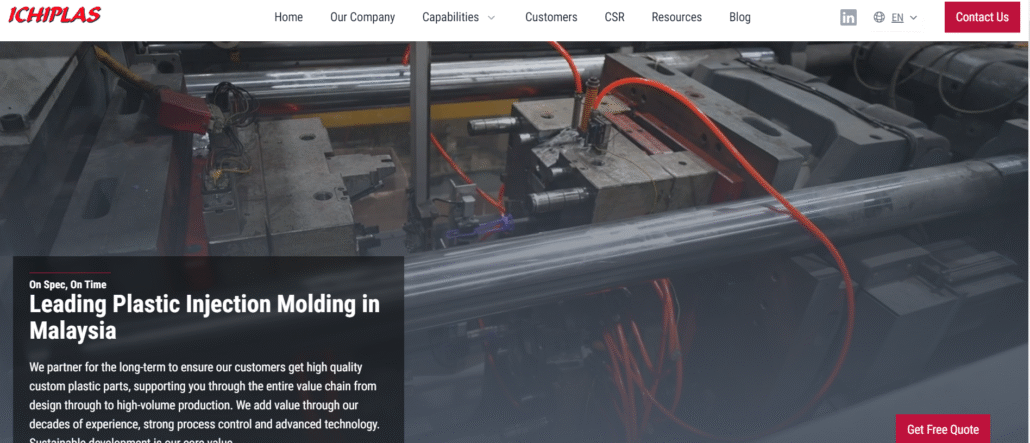
Year of establishment: 1994
Number of employees: 100-200
Business type: The company mainly fabricates molds and delivers large-scale injection molding services for custom plastic injection molding, including overmolding and insert molding
Website and Contact
Website: https://ichiplas.com/
Email: grace.wong@sales-ichiplas.com
Phone: +607-8637990
Address: 1C, Jalan Indah Gemilang 4, Taman Perindustrian Gemilang, 81800 Ulu Tiram, Johor Bahru, Malaysia
Company Profile
Since 1994, Ichiplas has been a strategic plastic injection molding partner for some of the world’s most recognized brands. Headquartered in Johor Bahru, Malaysia, they are dedicated to delivering mission-critical plastic components that meet the rigorous quality and volume demands of global leaders in technology and manufacturing. With ISO 9001:2015 certification, they offer end-to-end services from mould design and fabrication, to plastic injection molding and final assembly to clients globally.
Services
Plastic Injection Molding
Overmolding and Insert Molding
Mold Fabrication and Tooling
Secondary Processes
Pros
1. Reputation for quality and reliability after three decades of experience in mold fabrication and plastic injection molding
2. Commitment to quality assurance with ISO 9001:2015 certification
3. Global clientele – Primarily focuses on end-customers outside of Malaysia, able to support customers from US to EU and more
Cons
1. Geographical limitation with base in Malaysia only
2. Focus only on plastic injection molding. Unable to support other related manufacturing like blow moulding, extrusion moulding or CNC
3. Market Competition: In the plastic injection molding sector
If you are looking for plastic injection molding companies from Malaysia who has ISO certificate company, Ichiplas would be one your options as well.
Conclusion
However, in recent years, Malaysia’s injection molding industry has developed into a crucial component of the global manufacturing ecosystem due to technological progression, availability of a skilled labor force, and emphasis on quality. The industry can adjust to market needs and provide revolutionary products to various business domains such as automotive, medical devices, electronics, aerospace, and many others that make it profitable. Malaysia’s injection molding sector is one of the sectors that emphasizes precision engineering, efficiency, and sustainability. On the other hand, companies spare no effort in investing in advanced machinery and automation as well as research and development intended to enhance production processes that conform to evolving international standards. This dedication also allows the industry to deliver high-quality products to local and global markets. In the future, the injection molding industry of Malaysia will please all. Yet, its strategic emphasis on technological innovation, sustainability, and global expansion will maintain its edge as the leading body in the international manufacturing industry.











